October 23, 2009
Air Date: October 23, 2009
FULL SHOW
SEGMENTS
Health Risks of Nuclear Power and Testing
View the page for this story
Using baby teeth, researchers have analyzed the amount of the radioactive chemical strontium-90 in peoples’ bodies who lived in the 1960s—an era of above ground nuclear testing in the U.S. Through this research, scientists at the Radiation and Public Health Project (RPHP) in New York are making the connection between strontium-90 and cancer. Host Steve Curwood talks with the executive director of RPHP, Joseph Mangano, about this study and other studies that link a person’s proximity to nuclear power plants and cancer. (06:00)
Energy’s Hidden Costs
View the page for this story
The energy we use comes with a hidden price tag in the billions of dollars, according to a new study by the National Academy of Sciences National Research Council. Host Jeff Young and Dan Greenbaum, NAS study panelist, break down the hidden costs. (06:00)
Building Green with Less Green
/ Jeff YoungView the page for this story
Host Jeff Young visits a super energy-efficient, solar powered house in Maine. Its owner uses technology he calls “state of the shelf,” rather than state of the art. The goal is a green house that’s as economically affordable as it is environmentally sustainable. (06:40)
Government Greenbacks for Greener Homes
View the page for this story
A new pilot program has emerged from the recently announced "Recovery through Retrofit" plan, and it tackles the tough issue of financing green renovation projects -- in your house! Host Steve Curwood speaks with Renewable Funding president Cisco DeVries to learn how efficiently retrofitting your home is not only easy, but may actually save you money. (06:00)
Big Money to Green Low Income Housing
View the page for this story
The private, nonprofit development group Enterprise pledged four billion dollars to make low-income housing more energy efficient and healthy to live in. Enterprise’s Dana Bourland talks with host Jeff Young about how those at the lower end of the economic spectrum are hit hardest by home energy prices. (05:30)
The Battery of Southeast Asia
/ Mary StuckyView the page for this story
Across Southeast Asia, hydroelectric dams are being planned and built along the biologically diverse Mekong River and its tributaries. In Laos, seven large dams are currently under construction, tapping much of the electricity for export to bring in needed revenue and development for the struggling nation. But environmental groups in the region oppose these big dams, calling them threats to Laos' amazing biodiversity. Mary Stucky traveled to Laos and has our report. (09:00)
Science Note/Tree Power
/ Nirja ParekhView the page for this story
Researchers discover that maple trees generate small, detectable amounts of electricity. Nirja Parekh reports on how tree power is the newest low-cost, green technology. (01:45)
DEAD-icated Scientists
View the page for this story
In the event of a Zombie infestation, what would you do? Quarantine the zombies, try to develop a cure, or load your shotgun and aim for the head? Philip Munz, author of When Zombies Attack!: Mathematical Modeling of an Outbreak of Zombie Infection shares his findings with host Jeff Young. (06:00)
Show Credits and Funders
Show Transcript
HOSTS: Steve Curwood, Jeff Young
GUESTS: Joseph Mangano, Dan Greenbaum, Cisco DeVries, Dana Bourland, Philip Munz
NOTE: Nirja Parekh
REPORTERS: Mary Stucky
[THEME]
CURWOOD: From Public Radio International - this is Living on Earth.
[THEME]
CURWOOD: I’m Steve Curwood.
YOUNG: And I’m Jeff Young. How a Cold War trove of baby teeth illuminates the dangers of our nuclear world.
MANGANO: What we found was staggering. We found that people who had died of cancer have more than double the strontium-90 level in their teeth than healthy people.
CURWOOD: Also, scientists are only now beginning to understand the biological richness of Southeast Asia.
CHAPMAN: The Mekong should now be synonymous with Amazon, with Borneo, with Congo. It conjures up images of wild places and I tell you it doesn’t get much wilder than this.
CURWOOD: But now that wildlife is threatened by hydropower.
YOUNG: Plus…
[SCREAMS OF TERROR]
YOUNG: The math behind some movie monsters. We’ll have those stories and more this week on Living on Earth, so stick around.
ANNOUNCER: Support for Living on Earth comes from the National Science Foundation and Stonyfield Farm.
Health Risks of Nuclear Power and Testing
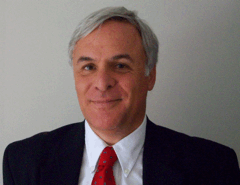
Joseph Mangano, MPH, MBA, is the Executive Director of the Radiation and Public Health Project.
YOUNG: From the Jennifer and Ted Stanley Studios in Somerville, Massachusetts - this is Living on Earth. I’m Jeff Young.
CURWOOD: And I’m Steve Curwood. Nuclear radiation can cause cancer, and when America stopped testing nuclear bombs in the atmosphere in 1963, research showed a decline in the levels of dangerous fallout in people. Now scientists at the Radiation and Public Health Project have published studies that apply the methods of that research to cancer rates of people living near nuclear power plants, with some startling results. With me now is Joseph Mangano, he’s an epidemiologist and the executive director of this project. Mr. Mangano, welcome to Living on Earth.
MANGANO: Hi, how are you?
CURWOOD: Yeah, I read that you recently acquired some 85,000 baby teeth from an old World War II gunnery range in St. Louis. What’s the story behind how you got those teeth and what do baby teeth have to do anyway with your research?
MANGANO: To tell you how we acquired them, I’ll have to go back in history a bit to 1958 – a time when the United States and Soviet Union were engaged in a nuclear arms race. A lot of people were very worried about, not just nuclear war, but about the fallout from the bomb tests, and a group of citizens and scientists in St. Louis conceived the baby tooth study, in which they collected 320,000 baby teeth.
The purpose was to measure radioactive strontium-90 in baby teeth. And our group in the late 90’s began the same kind of tooth study near nuclear reactors in the U.S. And one day, I got a phone call from one of the faculty there, and he said that Joe, we were out at a storage area and we found 85,000 baby teeth leftover. This is a goldmine for researchers.
CURWOOD: So, what did you do with it?
MANGANO: One thing that original Washington University study did not do in the 60’s was look at the question, “What did atomic bomb tests do to people? How many people got cancer from bomb test fallout?” So, we took 6,000 teeth, males from St. Louis who were born in 1959, ’60, and ’61, who donated an incisor tooth and were not breastfed, and we did two things.
First of all, we wrote health surveys to people who we found a current address for, and second, we asked the Missouri health department to search their death records over the last 30 years. And out of all that we came up with a hundred tooth donors who have had cancer by age 50.

Joseph Mangano, MPH, MBA, is the Executive Director of the Radiation and Public Health Project.
We tested them in a laboratory for the same strontium-90; we also tested 200 teeth of healthy people. And what we found was staggering. We found that people who had died of cancer have more than double the strontium-90 level in their teeth from fallout than healthy people.
CURWOOD: How does strontium-90 enter the body, and how does it affect the body?
MANGANO: That’s a good question, and let’s just take it from the beginning: an atomic bomb explodes above the desert in Nevada. Many, many Americans remember the massive fallout clouds – they look like big mushroom clouds. Within that cloud are tiny metal particles of more than a hundred different radioactive chemicals, strontium-90 being one.
The cloud is then carried by prevailing winds and the fallout return to earth through precipitation and entered human bodies through the food chain. It rained into municipal water supplies, into pastures where cows graze. The strontium is chemically similar to calcium and the body thinks it’s calcium, so when you drink a glass of milk with strontium-90 in it, it goes right to the stomach, it very quickly goes into the blood stream, and just as quickly attaches to bone and teeth, which is just was calcium does, only calcium is healthy for the body. Strontium-90 is destructive.
It’s especially harmful because it attaches to bone, but it penetrates into the bone marrow. And in the bone marrow, the red and white blood cells that are the basis of the human immune system; the human immune response are formed, causing not just bone cancer or blood cancers, but essentially all cancers and even all immune diseases. It is a deadly chemical.
CURWOOD: Joseph Mangano, I want to turn now from radiation exposure from nuclear bomb testing to the matter of nuclear power. Your organization has a project you call the Tooth Fairy Project where you look at radiation hazards from nuclear power plants. What have you found from this research so far?
MANGANO: We found that close to nuclear plants the levels of strontium-90 are considerable higher than areas far away. Number two, we found that levels are going up – since the late 1980s they’ve gone up about 50 percent, as nuclear plants get older, and are corroding more, and emitting more radiation. And number three, we found the link with childhood cancer. We found that in counties closest to nuclear plants in New York and New Jersey, when strontium-90 in teeth went up, childhood cancer went up; when strontium-90 went down, childhood cancer went down.
CURWOOD: What tests have you conducted that show the effects of before and after a nuclear power plant closes?
MANGANO: We’ve done two studies, which looked at eight nuclear plants in the United States that were shut down permanently during the 1980’s and the 1990’s. And we found that in the first two years after nuclear reactors shut there was a very sharp plunge in the rate of infants that died, in the rate of children born with birth defects, and in the rate of children diagnosed with cancer.
CURWOOD: When you say the rates plunged, what exactly are you talking about?
MANGANO: Typically, childhood cancer rates go up slowly by say one percent a year. We found that in the first two years a decline of 25 percent. If you want to reduce childhood cancer, near nuclear plants, according to our research and of course needs to be followed up, but a quarter of them can be eliminated simply by closing the nuclear plant.
CURWOOD: Joseph Mangano is an epidemiologist and the executive director of the Radiation and Public Health Project in New York. Thank you so much, sir.
MANGANO: Oh, thank you.
Related links:
- To learn more about the Radiation and Public Health Project, click here
- Click here to hear a full interview with Joseph Mangano
Energy’s Hidden Costs
YOUNG: The radiation health effects study is one attempt to uncover a hidden price of our energy choices. Economists call these “externalities” -- the public health and environmental costs that do not show up in our energy bills. But we do pay for them eventually, one way or another. The National Academy of Sciences, National Research Council has put a number on those hidden energy costs and it’s a big one. Dan Greenbaum was on the Academies’ study panel. He researches air pollution impacts as president of the Health Effects Institute. Mr. Greenbaum, what price tag did the National Academies come up with?
GREENBAUM: We estimated that just for the cost related to continuing air pollution from power plants, and traffic, and heating our homes that we’re looking at over $120 billion dollars of health and other damages in the year 2005.
YOUNG: Just for one year?
GREENBAUM: For one year.
YOUNG: Now, where does that come from? What is costing us that?
GREENBAUM: Well, we looked primarily at emissions of nitrogen oxides, sulfur dioxide, and also the pollutants that cause ozone smog, and the biggest part of the estimates of our damage has to do with exposure to that particulate matter, which has been shown now in health studies to cause premature mortality. Roughly speaking, we estimated that the current levels of pollution from those sources cause between 18,000 and 20,000 deaths a year. Some would call our estimates an underestimate of these costs.
YOUNG: And what are the biggest offenders here? Where do we see the bulk of these costs?
GREENBAUM: Well, I think there were two major components of the 120 billion Dollars. One of those was coal-fired power plants; the other key place is transportation – cars and trucks. We looked at 406 power plants, which is almost every coal-fired power plant in the country, and about 50 percent of those were responsible for only 12 percent of the damage. So, they are newer, they are cleaner, they’ve been better controlled, but about ten percent of them were responsible for 43 percent of the damage. So, it’s a very concentrated problem in many respects.
YOUNG: So, when it came to exposing the hidden costs of our electricity, mostly it was about coal, and mostly about old coal?
GREENBAUM: That’s correct. We’re talking about older power plants being the biggest contributor to the damages that we estimated and by far coal was the biggest single contributor to that – to those damages.
YOUNG: So, coal, transportation…what about other sources of fuel that we use to generate our electricity? Are there any that stood out as not having so much hidden cost?
GREENBAUM: Well, we looked at most of the other ones. Electricity coming from natural gas did have some damage, but natural gas is much cleaner in the way it’s burned and the plants are generally newer, and we were – we estimated about a billion dollars a year of the 120 came from the natural gas plants. We also looked at nuclear plants, and at wind and solar. In the case of nuclear there were very, very few external effects of the sort that we were looking at, and the panel thought that the probability of an accident, which is the thing that many people worry about, is so low that per kilowatt hour of electricity generated that the external effects wouldn’t be as great. Wind and solar, similarly, very few effects that we saw.
YOUNG: Well you sure did a thorough job here. However, there are some things you didn’t take into account here. You didn’t really try to put a price tag on the potential climate change costs, or the costs of greenhouse gas emissions?
GREENBAUM: We could not pick a single number to make that estimate. There are a number of very detailed models that have been done to try and estimate these – it’s difficult to do because you’re talking about effects that are occurring pretty far in the future. And what we did is we found a range between dollar per ton of carbon dioxide and 100 dollars per ton of carbon dioxide emissions.
YOUNG: That’s a pretty big range.
GREENBAUM: A very big range, and what you see if for, like, coal and transportation that the damages, if 30 dollars per ton was the right number that the damages would be about equal to the ones that we estimated for non-climate damages.
YOUNG: So, it would be double the cost of what we’re already looking at.
GREENBAUM: Right, we didn’t make that choice, but if that was right choice for these numbers, it would result in a doubling of the damage costs.
YOUNG: But, in all likelihood, the fuels that would carry the highest carbon costs are by and large the same ones that have the large costs from the traditional, the conventional pollutants?
GREENBAUM: That’s correct. There are a lot of potential co-benefits of controlling emissions from power plants, for example, for both climate change and pollution.
YOUNG: What other things are not included in here? In other words, what hidden costs remain hidden despite your good efforts?
GREENBAUM: Well, we couldn’t fully quantify the effects on ecosystems, the effects of biofuels on water pollution, for example; the effects some hazardous air pollutants, such as mercury or lead; and there are also a set of external costs relating to national security, gird congestion on the electricity grid, and possible other things.
YOUNG: So, what are the major take-away lessons from all this?
GREENBAUM: Well, we’ve made a lot of progress on reducing conventional pollution, but this report tells us we have a lot of unfinished business. Room still to move to get further reductions to the tune of at least 120 billion dollars, although our estimate of those extra damages to health and the environment that are still happening is probably conservative, because we did not include climate change effects, effects on ecosystems and others.
YOUNG: Dan Greenbaum with Health Effects Institute, thanks for your time.
GREENBAUM: I’m really glad to be here.
YOUNG: You can read both that study and results from the radiation and public health project at our website LOE dot ORG.
[MUSIC: Fela “Monkey Banana” from ‘Zombie’ (Celluloid Records - 1985)]
CURWOOD: And just ahead, a new program to green America’s homes by greening homeowners’ pocketbooks. Keep listening to Living on Earth.
Building Green with Less Green
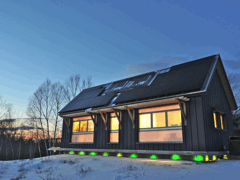
The green lights on the bottom of the house show when it’s producing more energy than it needs (glowing green) or using energy from the grid (glowing red).
YOUNG: It’s Living on Earth, I’m Jeff Young.
CURWOOD: And I’m Steve Curwood. Green housing is getting some greenbacks. Vice President Joe Biden recently rolled out a federal plan designed to cut red tape and provide grants called ‘Recovery Through Retrofit.’ He says it could cut 160 million tons of global warming gases every year by promoting energy efficient homes.
BIDEN: It will save families a combined 21 billion dollars annually in their energy bills if we do this the right way – while lessening our demand for foreign oil and preserving the environment to leave our children and grandchildren something closer to what we inherited. Not bad for a day’s work, if we can get all this done.
CURWOOD: There’s a lot attention now on how to put green housing within reach without putting households in the red. And that’s our focus for this part of the program today. We’ll hear about a big-money investment in greening low-income housing and explore ideas for financing energy efficient homes. And we start with a visit - by you Jeff - with a pioneering homeowner who says green living can be more affordable and accessible.
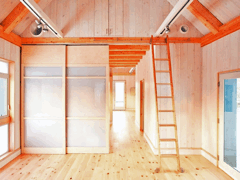
Over its first year, the house has generated five thousand more kilowatt hours from solar panels than it used.
YOUNG: Yeah, Dr. Keith Collins, a retired physician, brought together top designers and architects to help him build what he calls the Bright Built Barn. Dr. Collins said look for the tight little house, with a south-facing peaked roof on a hill. So I hit the road to mid-coast Maine.
[MUSIC]
[KNOCKING DOOR; DOOR OPENING]
YOUNG: Hello, there!
COLLINS: Hi, Jeff - Welcome to Maine.
YOUNG: Thanks for having me.
COLLINS: Well, thanks for coming up and I’d love to show you Bright Built Barn, and it’s a beautiful sunny day, and we’re making lots of electricity.
YOUNG: Dr. Collins has solar power in his place and many of the things you’d expect from energy-efficient design. Double thick insulated walls, triple paned windows and obsessive weatherproofing. But it also has something you might not expect – charm. Lots of natural light, pretty pine floors and exposed spruce beams reaching up to a high vaulted ceiling.
COLLINS: You know, some people think that to go green we should wear burlap bags and eat rocks, and I’m just not into suffering, you know? I think that if we put our minds to it we ought to be able to live very well, as well as protect the planet.
YOUNG: Let’s take a walk in here and talk a bit about your lighting, because I know that’s another area where we tend to use a lot of energy.
.gif)
Energy ratio for the green house. Energy production is green and energy consumption is in red, while the blue shows the energy flow to the grid.
COLLINS: If you look over here you see these lights are what are called LED lights – they’re light emitting diodes. They’re basically little computer chips that give off light. Each of these fixtures is using five watts and giving off the same amount of light as a 75-watt incandescent bulb, so there’s a 15 times more energy efficient.
[KNOCKING SOUNDS]
YOUNG: We climb above the moveable birch panel walls to the loft, for a look at the solar system: 30 voltaic panels provide electricity and solar thermal tubes heat water, which also heats the house. Dr. Collins likes the medical metaphor. He calls this the heart of the house. And in the corner, is the brain: a metal box with a digital display.
COLLINS: This is what I call my report card. Here it says – and this is from the day we turned on all the systems – how many kilowatt-hours have we consumed here in the barn, and it’s 1,247-kilowatt hours.
YOUNG: That’s for like a year, more than a year?
COLLINS: Yeah, that’s a year. However, we produce 6,342-kilowatt hours in that year. Giving us a net positive of 5,094-kilowatt hours as of today October 17, 2009.
YOUNG: So, your meter, your meter spins backwards?
COLLINS: Absolutely. And it spins backwards a lot. You know, basically any really sunny day, my meter’s spinning backwards.
YOUNG: And the grid, it’s your battery?
COLLINS: The grid is my battery. In other words, what we do is we put the energy out on the grid when we’re making excess, and when we’re not making excess, and we’re consuming more than we make, we draw from the grid.
YOUNG: There’s some information technology at work here to make everything play well together. But, by and large, this is low-tech, this isn’t high-tech?
COLLINS: And that’s what we tried to do. We were aiming for the state of the shelf, not the state of the art. A real goal in building this was not to build something that would be Buck Rogers, high-tech, something you needed a degree in astrophysics to run – this was something where anybody could have a house like this.

The green lights on the bottom of the house show when it’s producing more energy than it needs (glowing green) or using energy from the grid (glowing red).
[WALKING DOWN STEPS]
YOUNG: Putting clean electrons back into the grid is also part of Dr. Collins’ plan to make the house truly carbon-neutral. He kept tabs on the CO2 emissions from construction, even using local wood, and keeping the house small – just 30 by 24 feet – he still put 500 metric tons of CO2 into the atmosphere. Collins calls that his house’s carbon debt and he can only pay it off if the house lasts.
COLLINS: Everything in the barn is designed to last 200 years, except me. [Laugh] I’m not going to last 200 years, which means I’ve got to build something not just for me, I’ve got to build it for all those generations after me who will come to use it and have to feel that it is functional, but they also have to feel that it’s beautiful.
YOUNG: So, aesthetics matter. If it’s going to be green, it’s going to be good looking, too?
COLLINS: Absolutely, because, in fact ugly houses get smashed down. So, what we need to do is we need to make a space, which is beautiful so that people will take the energy to adapt it to their needs. We are then offsetting the carbon that we put off into the atmosphere to build it.
YOUNG: You’re paying back your carbon debt, little by little.
COLLINS: Absolutely, little by little, and just to give you some numbers: 5,000. Well, if you do the math, those 5,000-kilowatt hours equate to about five metric tons of carbon dioxide.
YOUNG: Five tons down, and 495 to go.
COLLINS: 495 to go, right? So, we’ve only got 99 more years to go, and we’ll have paid off our debt. We’re already planning the party.
YOUNG: Well, Dr. Keith Collins, thanks very much. It’s a great pleasure.
COLLINS: It was great to see you, thanks for coming by.
CURWOOD: So, it sounds like a nice place, Jeff, but what would it cost?
YOUNG: Well, a house like this one with the solar system would be about $220,000. Dr. Collins says that’s roughly the same as the cost of normal construction if you average the cost over the life of a 30-year mortgage. Because remember, he’s probably never going to have to pay another power or heat bill.
CURWOOD: But, the upfront cost is still higher.
YOUNG: Mm hmm, the upfront cost is the barrier.
Related link:
Click here for a diagram of a green house
Government Greenbacks for Greener Homes
CURWOOD: And that barrier is what folks working on the Property Assessed Clean Energy, or PACE concept, hope to break down. It’s a new financing program using tax-free bonds that helps homeowners make energy efficiency improvements without having to write a big check upfront. Cisco DeVries says this approach has the potential to reduce the amount of carbon dioxide released into the atmosphere by up to four to five percent. Mr. DeVries is president of the company Renewable Funding, which created the concept of property-assessed clean energy, and he joins us now. Cisco DeVries, welcome to Living on Earth.
DEVRIES: Hello Steve, it’s great to be with you!
CURWOOD: So, how does this new financing program work?
DEVRIES: This new program, which started in Berkeley, is designed to take a type of municipal financing that cities have been using for over a century and apply it to allowing property owners to make these energy efficiency and solar improvements. What it allows a property owner to do is install an energy efficiency retrofit, or a solar system, and then pay for the cost over ten or 20 years as an individual voluntary surcharge on their property tax bill. So, you know, we get rid of that big upfront cost, and allow property owners to pay for the improvement much like a utility bill over months and years.
CURWOOD: So, an important point to make is that the cost stays with the property, and not with the individual, correct?
DEVRIES: That’s one of the real pieces of magic here. An average homeowner in the Unites States moves every five to seven years these days, and that’s simply not long enough to recoup the benefits of making one of these deep improvements to your home. So, under this new program, a property owner who makes the improvement, and then moves, the new owner just comes in and picks up paying for the improvement, where the other property owner left off. The property tax surcharge just transfers automatically between owners, much like your utility just transfers to the next owner when the new owner moves in.
CURWOOD: Now, not everyone who wants to be more energy efficient owns a home, so what can this program do for renovating buildings like, you know, multi-family rental units?
DEVRIES: This has been a tricky wicket for a long time. In most cases, a renter of an apartment is paying the utility bill, but it’s the property owner that would have to put out the money in order to makes these improvements and reduce the bills – it’s called a split incentive. The first way that this program really helps is it allows property owners who have things like central heating, or central water heating, to use this Property Assessed Clean Energy model to make these improvements, reduce their energy costs for the parts of the bills that they’re paying. So, that’s a direct benefit to the property owner. But in addition, what we’re finding is that property owners in some cases are talking to the renters and saying, hey, let’s do this together. We’ll increase the rent a little bit, and you will be able to reduce your utility bill a little bit, and we’ll share in these savings.
CURWOOD: Now, where do the municipalities, the cities and towns, get the money to do this?
DEVRIES: Well, Steve, that’s a great question. One of the most important components of this program is that it is not a cost to a city. All the city does is enable the property owners to have a surcharge on their property tax bill, and then issues a bond, and that bond is then repaid through the property taxes. If there’s ever a problem in the repayment of property taxes, it’s just the bond owners who are affected. The city itself isn’t responsible. The only security then, for that bond, for the repayment, is the property tax. And that means that cities can go ahead and help this program get started, can make it a service to their communities, but their not taking on the risk, and not having to put the money up themselves. And that’s a real benefit right now, because there’s not a lot of governments out there that have extra money running around.
CURWOOD: What’s the catch here? You know, selling bonds at this time of the economy will be kind of difficult, for one thing.
DEVRIES: What we’re seeing today, the bond markets are getting better for bonds that are well received, that look very secure. So, our job in this program as it gets started is to make these bonds are secure, that the programs work well, that the property owners who are choosing to participate are doing so with a great deal of information and making good choices to receive real energy savings. If we do those things, then these bonds should be very secure, and they should be well received on the markets.
CURWOOD: So, Cisco, what gets you excited about this?
DEVRIES: We’ve known for decades that you can save money, that most property owners can save money on energy efficiency in their homes, but we haven’t been able to unlock that door. And here today we have this confluence of events: we have the priority around climate change; we have the fact that families are looking for way to save money, especially in this difficult economic time; and we’re trying to put people back to work. And that’s led to a real focus on solving this energy efficiency financing issue. The thing that really gets me excited is we have the opportunity with this program and some of the leadership in other programs we see coming down the pipe, to help transform the built environment, to really transform the way that people use energy, that they think of energy, and to reduce the amount of energy and greenhouse gas emissions coming from our homes and businesses.
CURWOOD: How big could this be, Cisco?
DEVRIES: The University of California Berkeley did a study looking at these programs and they said, boy, if this really starts to catch on nationwide, it could be a $280 billion financing program in not too long. And then we would be talking about reducing greenhouse gas emissions to the tune of 1.1 or more gigatons.
CURWOOD: And, at net not cost really to anybody?
DEVRIES: Property owners really want to do the right thing, but they also need to save money. This is not a time to be putting a lot of extra money out the door if you can avoid it. And I think what we’ve got here is an opportunity for people to make the retrofits to reduce their energy costs and to put some extra money in their pocket books at the end of the month. And that certainly is a win-win.
CURWOOD: Cisco DeVries is president of the company Renewable Funding, the creators of the PACE concept, the Property Assessed Clean Energy program. Thank you so much for taking this time.
DEVRIES: It was really my pleasure to be part of this, thank you, Steve.
Big Money to Green Low Income Housing
CURWOOD: Now, the PACE program to fund renewable power and other green improvements is one approach – and there are others focusing mostly on low-income households.
YOUNG: The private non-profit development group Enterprise plans to come up with four billion dollars in the next five years to retrofit or develop 75,000 green homes, partly by tapping in to the growing market in carbon offsets. Dana Bourland, the vice-president for Enterprise, Green Communities, says they try to make low-income housing more energy efficient because the people who live there get hit the hardest by utility costs.
BOURLAND: It’s astounding really when you look at it. There was a study of low-income households to look at what they were paying for their utility costs, and they’re paying at least four times more than a moderate income household is, just for energy, which means tradeoffs. So, they’re much more likely to skip their medical visits or even skip eating for a day, just to keep the lights on or keep the air conditioning going.
YOUNG: Now, not all the projects that you’re talking about are just about improving energy efficiency – this is a broader definition of “green”. Tell me about this project you have in Seattle?
BOURLAND: So, there’s one terrific development called Hyde Point, it’s a large redevelopment of public housing on the west side of Seattle. There were 60 homes built to a specific standard to really make those homes easier to breathe in. Mostly because they don’t have carpet, which really does attract sort of dirt and pollutants in it, and also installed filter systems for the whole house, so you’re getting the right amount of fresh air into the home and taking the stale air out. So, the children that moved in had asthma that was part of the requirement putting the families in those specific homes. Within a one year timeframe, those children are experiencing 60 percent increase in the number of days they don’t have symptoms related to asthma.
YOUNG: Now, how do you pay for all this stuff? Tell me about this what sounds to me like a very clever idea to use this whole notion of carbon offsets to help offset these costs.
BOURLAND: Enterprise realized that if you met the green community’s criteria, you’d be reducing carbon emissions by about two tons. So, we decided to figure out how to operate within the voluntary carbon market to buy offsets from developers of green communities’ projects that would allow them to pay for those energy efficiency measures that would result in the lower carbon emissions.
YOUNG: Now, what has to happen to make that happen? This is part of some legislation?
BOURLAND: Right now is just operating, so you, Jeff –
YOUNG: The voluntary market is happening?
BOURLAND: Exactly, it is part of the climate bill to think about a cap and trade system. That cap and trade system could generate as much as 50 to even 300 billion dollars.
YOUNG: So, if this goes large scale then some industry looking to offset its carbon pollution could basically buy a stake in one of your green houses?
BOURLAND: Exactly. That’s our goal, is to really link affordable housing into the green economy.
YOUNG: You know, we are of course, in this economic crisis, which had its start in the housing crisis, the foreclosure crisis. How’s that affecting the effort to green housing?
BOURLAND: It’s obviously not a good situation, but we are presented now with a tremendous opportunity to go into those homes and rehab them and do things, you know, on a moderate level but will have a tremendous impact for then new owner. And what we’re seeing is there is a slight correlation emerging between homes where the owners could not afford their utility bills coupled with their rising mortgage cost, just became a disaster. We forget, I think, sometimes that housing costs it’s not just your upfront rent payment or your mortgage payment, it is the operations and maintenance and that we’ve seen take a huge spike in terms of the cost for energy, for electricity and for water.
YOUNG: You know, part of I find interesting as you lay this stuff out is it’s not just green in an environmental sense, this is green in a dollars and cents sense. This is bottom line kind of thinking.
BOURLAND: Jeff, exactly. This is just good business sense. The other part of that though is what we’re seeing in terms of the engagement in this movement that you and I both live somewhere and hopefully most of us do have a home that we have control over or an apartment where we can actually take small steps, or larger steps, and play a large role in the global situation that we’re facing in terms of climate change.
YOUNG: I don’t know why this just occurred to me, but the root of the word ecology, eco, means house.
BOURLAND: It does, yes.
YOUNG: Home, sweet, home.
BOURLAND: Home, sweet, home.
YOUNG: Dana Bourland is vice president for Enterprise Green Communities. Thanks for visiting.
BOURLAND: Thank you.
YOUNG: Well, as we heard climate change legislation could have a big impact on green housing. Both the U.S. Senate and President Obama are now turning their attention to that legislation, and so will we on our next program. For a preview go to our website LOE dot ORG.
[MUSIC: Jeremy Udden “Curbs” from Plainville (Fresh Sound New Talent 2009)]
CURWOOD: Coming up, how green waterpower might be very bad for biodiversity.
CHAPMAN: Development is important to the welfare of our people, environment is also important to the welfare of our people. And I don’t think there’s anywhere on Earth where you have the mixture of high biodiversity, yet high threat.
CURWOOD: Hydropower on the Mekong - Stay with us on Living on Earth.
ANNOUNCER: Support for the environmental health desk at Living On Earth comes from the Cedar Tree Foundation. Support also comes from the Richard and Rhoda Goldman fund for coverage of population and the environment. And from Gilman Ordway for coverage of conservation and environmental change. This is Living On Earth on PRI, Public Radio International.
The Battery of Southeast Asia
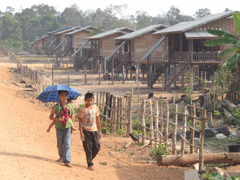
The Nam Theun 2 Power Company built 17 new villages for people whose homes and fields were flooded. (Mary Stucky)
YOUNG: It's Living on Earth – I’m Jeff Young.
CURWOOD: And I’m Steve Curwood. In the United States, Canada and Europe, some old hydroelectric dams are being torn down, rejected as environmentally destructive or too expensive to repair or replace. But that’s not the case in parts of the developing world, including Southeast Asia. There dams are being built along the biologically rich Mekong River and its tributaries. In just one small country, Laos, seven large dams are currently under construction, and over 50 more are on the drawing board. As Mary Stucky reports, some see this as a major threat to biodiversity.
[SOUNDS OF MARKET; VOICES; RUSTLING SOUNDS]

Market on the outskirts of Vientiane, Laos. Scientists have made new species discoveries in markets such as this.
Photo: Mary Stucky
STUCKY: At a bustling food market on the outskirts of Vientiane, the capital of Laos, vendors -- many of them women and children sit behind tables topped with umbrellas. There are piles of cabbage, bright red chilies in plastic bowls, and tiny speckled eggs stacked in cardboard cartons. Then there are the real delicacies -- from furry rodents to deep-fried insects.
CHAPMAN: This is fine local Lao fare. It tastes good too actually. I do recommend the crickets.
STUCKY: That’s Stuart Chapman of the World Wildlife Fund. He says markets like this one offer a tremendous variety of food and some amazing scientific discoveries.
CHAPMAN: Of course when you have people living in close proximity to the forest, these people come across the rare, the endangered and the unusual and in very many cases they are considered to be food and end up in markets such as this.
STUCKY: Chapman says scientists have been discovering an average of two new species every week for the last ten years in and along Southeast Asia’s Mekong River. Among them – a bright pink millipede that produces cyanide in defense; a rat thought to be extinct for 11 million years; and a spider the size of a dinner plate.
CHAPMAN: The Mekong should now be synonymous with Amazon, with Borneo, with Congo. It conjures up images of wild places and I tell you it doesn’t get much wilder than this.
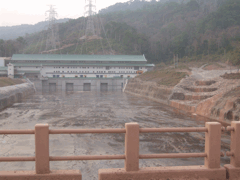
The Nam Theun 2 dam project is expected to bring two billion dollars into Laos. Mary Stucky
STUCKY: Chapman says that wildness and the Mekong’s unique biodiversity are at risk – victims of hunting, deforestation and development – specifically hydroelectric dams. The Laos Mekong is well suited for hydropower and officials here want Laos to become what they call “the battery of Southeast Asia.” Earning billions by building dams and selling the electricity they produce to neighboring countries.
[WHIRRING ENGINE SOUND]
STUCKY: In Central Laos, a road grader levels a two-lane highway near a major tributary of the Mekong River. It’s part of the massive one and a quarter billion dollar Nam Theun two dam project that’s expected to generate 1,070 megawatts by the end of the year. Aiden Glendinning represents the private company building the dam with funding from international shareholders and loans from the Asian Development Bank and the World Bank. Glendinning says revenue from the project will be used by the government to develop the country and reduce poverty.
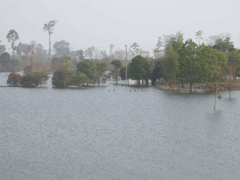
Areas flooded by the Nam Theun 2 dam project.
(Photo: Mary Stucky)
GLENDINNING: 95 percent of the electricity will be sold to Thailand at a pre-arranged rate as a guaranteed customer. So it provides financial security for the government. They’re going to get two billion dollars in royalties from the dam over the next 25 years and after that then they own the whole lot.
STUCKY: 19 villages have been flooded to create a 174 square mile reservoir for the dam. More than 6,000 people had to move, their rice fields and riverbank gardens flooded, their fisheries lost. Still, Nam Theun Two is meant to be a model for how to minimize environmental damage and lift the country out of poverty.
GLENDINNING: The Minister of Foreign Affairs here several years ago told diplomats and aid workers that the Lao people didn’t want to live in a museum that other people can come to visit and enjoy. They wanted to have better lives. They wanted refrigerators and cars and education for their children. And you can’t begrudge them that.
[CHILDREN VOICES]
STUCKY: The power company built 17 new villages for people whose homes and fields were flooded. These villages have new schools, roads medical clinics, and improved water supplies. Each family was given a new house complete with a latrine and electricity. Few residents would talk on tape but many say they’re happy with the houses and roads. But these improved living conditions haven’t reduced their worries about how to make living.
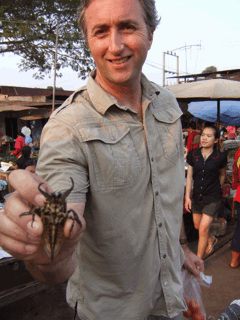
The World Wildlife Fund’s Stuart Chapman with a Lao delicacy. (Mary Stucky)
[MAN SPEAKING LAO]
STUCKY: The fishing is okay, says this fisherman, but there aren’t enough buyers for his fish. Most Laotians are poor, desperate for jobs and a better economy, says Stephen Lintner, a technical advisor for the World Bank. He says this dam will help.
LINTNER: Nam Theun two is premised on the principle that it is a way for the government to generate revenues that can be applied to poverty reduction and better environmental management. If used properly that revenue can make a major contribution to the development futures of the country.
STUCKY: Lintner says dams help in another way – they can be used to fight the ravages of climate change.
LINTNER: What’s happening is with climate change you’re having less predictability of the amount of rainfall you’ll have, so that dams are being increasingly used to store water to allow for better regulation.
MIDDLETON: The Mekong region has an opportunity to leapfrog the destructive dam development we’ve seen in other regions of the world and instead jump into a renewable energy future, into a sustainable energy future. There are far better technologies now for generating electricity, which makes dams last century’s technology.
STUCKY: That’s Carl Middleton of International Rivers, an advocacy organization opposed to hydroelectric dams. Instead of building dams, Middleton wants western governments to assist Laos in developing energy alternatives such as solar and wind. In Laos, the Mekong River supports a fishery that’s estimated at $50 million a year. Middleton says dams will permanently damage the river threatening Laotians’ food security and livelihoods, water to irrigate their crops, and even transportation. Middleton says fishermen are often the first to feel the negative effects of dams, which can block migrations of many fish species and change the natural ebb and flow of the Mekong River.
[SOUND OF BOATS ON RIVER]
MIDDLETON: The biodiversity has adapted to the shape of the Mekong River’s flood pulse. Between an extreme high during the rainy season, and a relative low during the dry season, and it’s this shape, this characteristic that makes the ecosystem itself so productive. By building dams you’re changing the shape of this hydrograph. It will change the biodiversity of the region.
[BOAT MOTOR]

The Nam Theun 2 Power Company built 17 new villages for people whose homes and fields were flooded. (Mary Stucky)
STUCKY: A long tail boat heads to what’s called the Siphandone or “four thousand islands” in Southern Laos near the Cambodian border. These waters are home to one of the most magical species on earth – the Irrawaddy dolphins.
[BOATMAN SPEAKS LAO; MOTOR CUTS OUT; WATER LAPPING]
STUCKY: We stop within sight of the dolphin feeding grounds. Suddenly, a grey fin slices the water. In a flash, there’s another.
LAO MAN: The fish.
STUCKY: Dolphins, yeah! Oh, they’re beautiful. There are fewer than 80 Irrawaddy dolphins left in the Mekong, and their numbers are dwindling rapidly. A recent World Wildlife Fund report points to DDT, PCBs and mercury pollution. The government of Laos has accepted a proposal from a Malaysian company to build an enormous hydropower dam in the area where the dolphins come to feed. Opponents say the dam at Siphandone would devastate the remaining dolphins and affect fish catches dramatically. The World Wildlife Fund’s Chapman says areas like Siphandone should be avoided but he supports allowing some dams in less sensitive places and wants to be sure people are provided with a way to make a living.

There are fewer than 80 Irrawaddy dolphins left in the Mekong and their numbers are dwindling rapidly.
Photo: Courtesy of the World Wildlife Fund
CHAPMAN: Yes, development is important to the welfare of our people, environment is also important to the welfare of our people. I don’t think there’s anywhere in on earth where you have the mixture of high biodiversity, yet high threat.
STUCKY: And, says Chapman that threat is not just in Laos. The Mekong River is more than 3,000 miles long and runs through six countries. Environmental groups have called for a multi-country agreement to preserve the river and its ecosystem. But so far countries on the Mekong are still proposing and building new dams as a way to meet the regions’ need for financial capital and for energy. For Living on Earth, I’m Mary Stucky, in Siphandone, Laos.
CURWOOD: For photographs – go to our website, LOE dot ORG
Related links:
- Species discoveries of the last decade in the Greater Mekong
- Nam Theun 2 Power Company
- World Wildlife Fund Greater Mekong Programme
- International Rivers – Laos
[MUSIC: Fats Waller “Abercrombie Was A Zombie” from ‘Fats Waller 1940 – 41’ (Chronological Classics)]
CURWOOD: Just ahead – some monster math – but first this note on emerging science from Nirja Parekh.
Science Note/Tree Power
[SCIENCE NOTE THEME]
PAREKH: The maple is already famous for its deliciously sweet syrup, but new technology could make the trees a sweet spot for energy, too. Research from the University of Washington shows big leaf maples can run an electrical circuit. The scientists found that the trees can produce a stable voltage of up to a few hundred millivolts, if they stick one electrode into the tree and one electrode into the soil.
This process sounds similar to popular kid’s science fair experiments like the potato or lemon battery. These generate an electrical current through a chemical reaction that moves electrons between electrodes from two different metals. Tree power uses a different mechanism, with electrodes of the same metal and, most importantly, it relies on a device called a boost converter.
This tiny, ingenious, custom-built gadget stores the tree’s miniscule voltage, and concentrates it into a larger, usable output. But don’t run out to your backyard and try to plug in your iPod. The tree power can’t support regular electronics, but it can run low-power sensors. These could be engineered to monitor environmental conditions and detect forest fires in the area.
Researchers say they are not certain where the voltage comes from, but say it might prove useful if it could be harnessed to check on the overall health of the tree. That’s necessary as climate change impacts the places where the maple tree thrives. That’s this week's note on emerging science. I’m Nirja Parekh.
Related link:
University of Washington Press Release
DEAD-icated Scientists

If properly armed, an average human can fend off 7-8 classic, slow-moving zombies. Modern zombies move faster. (http://www.flickr.com/photos/purplemattfish/3714903911/)
[THEME]
YOUNG: We recently came across an alarming paper in the scientific journal Infectious Disease Modeling Research Progress. A team of mathematicians from Canada modeled the potential outbreak of a new disease and found -- quoting here - "an outbreak is likely to be disastrous unless extremely aggressive tactics are employed. It’s imperative that those infected are dealt with quickly or else we are all in a great deal of trouble" – end quote. Well, that got our attention, so we called up one of the paper's authors, Philip Munz at Carleton University in Ottawa. So – Philip Munz - what exactly is this infection we are talking about?
MUNZ: Uh, sadly, this infection is a zombie outbreak.

The zombie virus is transmitted through biting. A newly infected victim may retain human characteristics during the latency period which can last between one minute and half a movie. (http://www.flickr.com/photos/captaintim/3081877028/)
[SCREAMS OF TERROR; HORROR MOVIE MUSIC]
YOUNG: Zombies, you say?
MUNZ: Zombies, yes.
[OLD MOVIE SOUNDS; SNARLING ANIMAL]
YOUNG: Okay, so this is a serious mathematical model based on a fictitious horror movie scenario– do I understand this?
MUNZ: This is some heavy math and some realistic math dealing with the fictional zombie disease.
YOUNG: First off, what kind of zombies are we talking about here because, you know, as any fan of zombie movies would know, not all zombies are the same. What zombies are yours like?
MUNZ: Oh no, yeah, you’re preaching the choir when you talk about all the different types of zombies. The zombies that we cover are the ones that you see in the 1968 movie, “Night of the Living Dead,” which was the first real pop-culture zombie flick.
[MAN SAYING “THE DEAD WHO LIVE ON LIVING FLESH”; SCREAMING VOICES; MAN SAYING “NIGHT OF THE LIVING DEAD…”]
YOUNG: [Laughs] The classical approach, if you will, to zombies.
MUNZ: Yes, the classical approach.
YOUNG: Okay, so zombie enters your town, what happens, how does the model play out?
MUNZ: So, yes, our ideas were sort of taken out of movies where, like in “Shaun of the Dead,” people don’t realize why someone attacked them and that someone actually ends up being a zombie.
[MAN SAYING “OH MY GOD, SHE’S SO DRUNK…”]
MUNZ: And then before people actually start realizing what’s happening, there’s already quite a large number of zombies around in the city.
YOUNG: Hmm, okay. What might we do about it? Could we quarantine them?

If properly armed, an average human can fend off 7-8 classic, slow-moving zombies. Modern zombies move faster. (http://www.flickr.com/photos/purplemattfish/3714903911/)
MUNZ: Well, that’s actually one of the things we look at in the paper. We thought that the quarantine would be the fastest thing that you could coordinate on such as short notice. The problem was…was that with zombies could can tell that they’re zombies, with people who are infected you can’t so much tell if they’ve been infected by a zombie if they’re not a zombie yet.
YOUNG: Ah, so there’s some latency between infection and full-blown zombieism.
MUNZ: Yes. And again, stuff that you see in movies where the boyfriend gets bit, and he’s like, oh I’m fine. But, then halfway through the movie, they’ve got the dramatic interlude where the girlfriend has to take out her boyfriend.
[SOUNDS OF HEAVING BREATHING; PHONE OPERATOR TONE; WOMAN SAYING “LOUIS, WHAT ARE YOU DOING?”; ZOMBIE SNARL]
YOUNG: Happens all the time.
MUNZ: Yeah. You know, so it’s not an instantaneous change from a human to a turning into a zombie.
YOUNG: So, if you can’t successfully quarantine every one, if just a few escape the quarantine doesn’t work, according to your model, is that right?
MUNZ: Exactly, the quarantine doesn’t work, and it’s very hard to find these people who are infected, but not yet zombies.
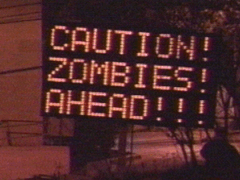
An early warning system would be useful in the event of outbreak. (http://www.flickr.com/photos/reana/3238910501/)
YOUNG: Okay, so quarantine is out. Doesn’t work. Scientists are hard at work to find out what this is about; they come up with a cure. Is that an option?
MUNZ: Yeah. Say the quarantine at least was a little bit helpful and they did come up with a cure – what possibilities might the cure hold? So our cure changes a zombie back to a human, pretty much right away. But, then once the person is human again, they’re susceptible to turning back into a zombie.
YOUNG: Oh, so it’s not a vaccine?
MUNZ: No, it’s not a vaccine. Even so, we thought well, let’s give it a try; let’s see what happens with the cure. And we were actually able to come up with a bit of a state where if we had enough resources, there’s only about ten percent human at any one time and the rest of the people in the city have turned into zombies.
YOUNG: That’s pretty grim; the cure is not sounding like a great option here. So, what is the ultimate solution here? I’m imagining the scene in the movie where the scientist, possibly played by Jeff Goldblum, goes to the authorities and says here’s what we have to do.
MUNZ: Uh, the assistant to Jeff Goldblum would be me, in that movie. Actually, the scientists would say the only chance we have is lethal force.
YOUNG: So, lock and load, aim for the head, that’s the ultimate recommendation here?
[Man speaking: “Yeah, okay, Chief, if I were surrounded by six or eight of these things, would I stand a chance with them?” “Well, there’s no problem, if you had a gun, shoot ‘em in the head, that’s a sure way to kill ‘em, if you don’t, get yourself a club or a torch – beat ‘em or burn ‘em, they go up pretty easy.”]
MUNZ: So, we though, okay, let’s see what we could do to model that, using math that actually gave proof to the fact that, yeah, at the end of those movies when the army comes in and takes out, wipes out, a whole bunch of zombies at a time, that’s actually a feasible solution.
YOUNG: As a mathematician, does this add to your enjoyment of zombie movies? To go to one, watch it, and say, yep, that’s the way it would happen?
MUNZ: [Laughs] I do that with pretty much all the movies, not just zombie movies. Well, could the Borg take over the human race?
YOUNG: [Laughs] What about romantic comedies? Do you apply your mathematically modeling to rom-coms?
MUNZ: Those ones actually, there is no logic, in those.
YOUNG: Good point. [Laughs] Philip Munz’s paper is called “When Zombies Attack: Mathematically Modeling of an Outbreak of Zombie Infection”. Great fun talking with you.
MUNZ: Well, thank you for having me.
YOUNG: And, you know, it sounds like you got a big brain…my advice: be careful out there.
MUNZ: [Laughs] Yeah…they want me for my brain, those zombies.
Related links:
- “When Zombies Attack!: Mathematical Modelling of an Outbreak of Zombie Infection” appeared in the Infectious Disease Modelling Research Progress.
- Night of the Living Dead established the pop cultural understanding of flesh eaters.
[MUSIC: Nellie McKay “Zombie” from ‘Obligatory Villagers’ (Hungry Mouse - 2007)]
CURWOOD: Living on Earth is produced by the World Media Foundation. Our crew includes Bobby Bascomb, Eileen Bolinsky, Bruce Gellerman, Ingrid Lobet, Jessie Martin, Helen Palmer, Jessica Ilyse Smith, Ike Sriskandarajah, and Mitra Taj, with help from Sarah Calkins, Marilyn Govoni, and Sammy Souza.
YOUNG: Our interns are Quincy Campbell and Nirja Parekh. Jeff Turton is our technical director. Alison Lirish Dean composed our themes. You can find us anytime at LOE dot ORG. I'm Jeff Young.
CURWOOD: And I’m Steve Curwood. Thanks for listening!
ANNOUNCER: Funding for Living On Earth comes from the National Science Foundation supporting coverage of emerging science. And Stonyfield farm, organic yogurt and smoothies. Stonyfield pays its farmers not to use artificial growth hormones on their cows. Details at Stonyfield dot com. Support also comes from you, our listeners. The Ford Foundation, The Town Creek Foundation, The Oak Foundation—supporting coverage of climate change and marine issues. The Bill and Melinda Gates foundation, dedicated to the idea that all people deserve the chance at a healthy and productive life. Information at Gates foundation dot org. And Pax World Mutual Funds, socially and environmentally sustainable investing. Pax world for tomorrow. On the web at pax world dot com.
ANNOUNCER 2: PRI – Public Radio International
Living on Earth wants to hear from you!
Living on Earth
62 Calef Highway, Suite 212
Lee, NH 03861
Telephone: 617-287-4121
E-mail: comments@loe.org
Newsletter [Click here]
Donate to Living on Earth!
Living on Earth is an independent media program and relies entirely on contributions from listeners and institutions supporting public service. Please donate now to preserve an independent environmental voice.
NewsletterLiving on Earth offers a weekly delivery of the show's rundown to your mailbox. Sign up for our newsletter today!
 Sailors For The Sea: Be the change you want to sea.
Sailors For The Sea: Be the change you want to sea.
 The Grantham Foundation for the Protection of the Environment: Committed to protecting and improving the health of the global environment.
The Grantham Foundation for the Protection of the Environment: Committed to protecting and improving the health of the global environment.
 Contribute to Living on Earth and receive, as our gift to you, an archival print of one of Mark Seth Lender's extraordinary wildlife photographs. Follow the link to see Mark's current collection of photographs.
Contribute to Living on Earth and receive, as our gift to you, an archival print of one of Mark Seth Lender's extraordinary wildlife photographs. Follow the link to see Mark's current collection of photographs.
 Buy a signed copy of Mark Seth Lender's book Smeagull the Seagull & support Living on Earth
Buy a signed copy of Mark Seth Lender's book Smeagull the Seagull & support Living on Earth

